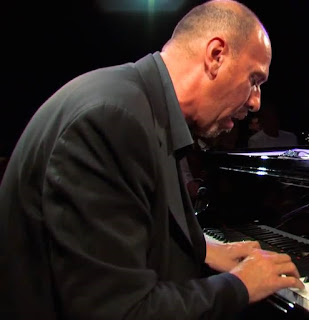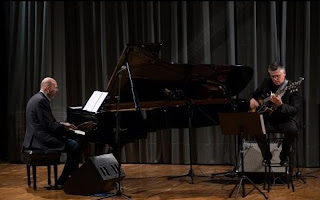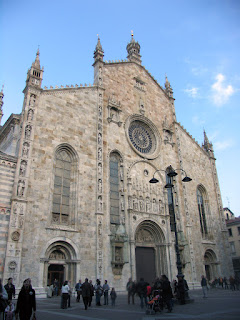Artist who died tragically young was key figure in Futurism
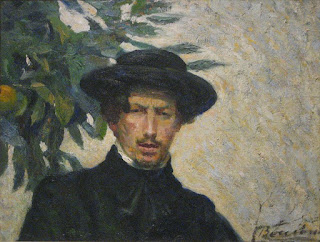 |
Boccioni's 1905 self-portrait, which can be found in the
Metropolitan Museum of Art in New York City |
The painter Umberto Boccioni, who became arguably the leading artist of Italian Futurism before the First World War, was born on this day in 1882 in Reggio Calabria.
Futurism was an avant-garde artistic, social and political movement that was launched by the poet
Filippo Tommaso Marinetti in 1909. Its ethos was to embrace modernity and free Italy from what was perceived as a stifling obsession with the past.
The Futurists admired the speed and technological advancement of cars and aeroplanes and the new industrial cities, all of which they saw as demonstrating the triumph of humanity over nature through invention. Their work attempted to capture the dynamism of life in a modern city, creating images that convey a sense of the power and energy of industrial machinery and the passion and violence of social change.
Boccioni became part of the movement after meeting Marinetti in Milan early in 1910, after which he joined
Giacomo Balla, Gino Severini, Carlo Carrà and
Luigi Russolo in signing
Il manifesto dei pittori futuristi - the Manifesto of Futurist Painters.
 |
Boccioni's The City Rises is considered by many art
historians to be the first true Futurist painting |
In the same year, Boccioni completed one of his finest works, entitled
La città che sale, which is translated as
The City Rises. The painting, which many consider to be the first truly Futurist painting, combines static images of building construction as the background to the scene, but in which the dominant image is of men and horses melded together, the men desperately trying to harness control of the beasts, suggesting a primeval conflict between humanity and beasts in a changing, mechanised world.
Boccioni became the main theorist of the artistic movement but only after he and Severini and other Futurists traveled to Paris in around 1911 and witnessed the
Cubism of Georges Braque and Pablo Picasso did the movement begin to take real shape.
The influence of this was visible in Boccioni’s
La strada entra nella casa -
The Street Enters the House - later in 1911, which had geometric elements and the perspectival distortion familiar in Cubism, as the artist sought to create the sensation of the noises and images of the street filling the house on the opening of a window.
 |
The Farewells - part of Boccione's State of Mind series - can
be viewed at the Museum of Modern Art, also in New York |
His series
Stati d'animo -
States of Mind - contained similar geometric features, while
La risata -
The Laugh - created a scene that is broken apart and distinctly abstracted by a loss of structural borders, in line with the Cubist and Futurist demand that audiences dissect the images seen in everyday life, and notice each piece and its contribution to the whole.
Boccioni also became interested in sculpture. In 1912 he published the
Manifesto of Futurist Sculpture, in which he advocated the use in sculpture of non-traditional materials such as glass, wood, cement, cloth, and electric lights, and for different materials to be used in combination
in one piece of sculpture.
His most famous work,
Unique Forms of Continuity in Space (1913), is one of the masterpieces of early modern sculpture. Cast in bronze some years after his death, the piece is seen as an expression of movement and fluidity. It is depicted on the Italian-issue 20 cent euro coin.
 |
Boccione's Dynamism of a Cyclist (1913) is on display
at the Peggy Guggenheim Collection in Venice |
Boccioni’s father was a government employee whose job required him to make frequent changes of location. Soon after Boccioni’s birth, the family relocated to the north and he and his older sister Amelia grew up largely in
Forlì, Genoa and
Padua. At the age of 15, in 1897, Boccioni moved with his father to Catania in Sicily, where he would finish school.
In around 1898, he moved to Rome and studied art at the
Accademia di Belle Arti di Roma, where he met Gino Severini. Both he and Severini became students of Giacomo Balla, who introduced them to the modern Divisionist technique.
Boccioni’s style at the time leaned towards the neo-impressionist. It was around the time he was in Rome that he produced his 1905 self-portrait, which differs greatly from his Futurism.
After spending time in Paris and Russia, Boccioni moved to Milan in 1907.
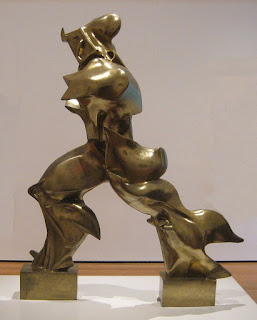 |
Boccione's best-known sculpture is Unique Forms
of Continuity in Space, completed in 2013 |
In 1914, Boccioni published his book
Futurist Painting and Sculpture, the most comprehensive account of Futurist artistic theory written by a founding member.
The following year, enthused by the possibility that the violence of the Great War in Europe would bring about some of the societal change that Futurists advocated, Boccioni - along with Marinetti, Russolo and other Futurists - signed up to fight as a volunteer.
The battalion he had joined disbanded in December 2015 and Boccioni returned to painting. But in June 1916 he was conscripted to the Italian Army and stationed outside
Verona with an artillery brigade.
During a training exercise in August, Boccioni was thrown from his horse and trampled, suffering injuries from which he died at the age of just 33. Many art historians say that with his death Italy’s Futurist movement was effectively at an end.
 |
Piazza Duomo in Reggio Calabria, the city where Umberto
Boccioni was born in 1882 |
Travel tip:
Reggio Calabria is the oldest city in Calabria, the most important in what became known as Magna Graecia - Great Greece - after settlers began to arrive in the 8th century BC. A few years after Boccioni left the area, a huge earthquake destroyed large parts of Reggio Calabria, which had to be substantially rebuilt. It is notable now for its fine Liberty buildings and its linear plan. The best of what could be salvaged of the Greek remains can be seen in the National Archaeological Museum of Magna Graecia, housed in Palazzo Piacentini.
 |
Catania has many Roman ruins, including this amphitheatre
in Piazza Stesicoro, which was buried by an earthquake in 1693 |
Travel tip:
The city of
Catania, where Boccioni completed his education, is located on the east coast of Sicily facing the Ionian Sea. It is one of the 10 biggest cities in Italy, with a population including the environs of 1.12 million. Catania has been virtually destroyed by earthquakes twice, in 1169 as well as 1693, and regularly witnesses volcanic eruptions from nearby Mount Etna. In the Renaissance, it was one of Italy's most important cultural, artistic and political centres and has enjoys a rich cultural legacy today, with numerous museums and churches, theatres and parks and many restaurants.
More reading:
How Carlo Carrà was applauded for capturing the violence at an anarchist's funeral
Luigi Russolo and the phenomenon of 'noise music'
The Futurist behind the famous conical Campari soda bottles
Also on this day:
1956: The birth of micro-biologist Carlo Urbani, who uncovered the SARS virus
2012: The death of three-times Giro d'Italia winner Fiorenzo Magni
Home








